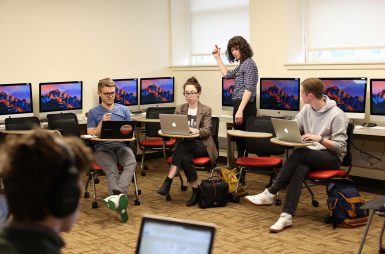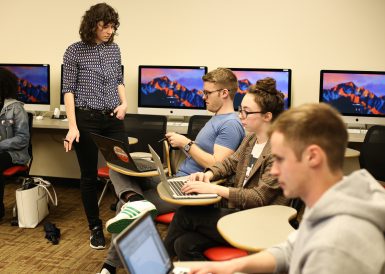Students, Kinsey Institute partner to tell same-sex love stories
Senior Bridget Murray thought she understood love.
The journalism and theater major is a student in The Media School’s MSCH-J460: Radio Innovation, which is teaming up with IU’s Kinsey Institute to document the experiences of same-sex couples in Indiana through audio storytelling.
“I loved hearing their stories,” Murray said. “It really put into perspective a lot of the news that maybe doesn’t affect me as much. Love seems like such an easy concept, but there are a lot of challenges that come with it. I loved talking to someone older who has lived and has a challenge that they work through every day.”

The endeavor started as an archive project, conceived by Stephanie Sanders, a provost professor of gender studies and a senior scientist at the Kinsey Institute. Sanders wanted to use primary sources to document a historic moment in time: the early years of the legalization of gay marriage. In particular, the institute wanted to document how couples in the area have grappled with these immense changes.
“We are interested in how long-term couples, who never dreamed of being legally married, experience this change of now being able to get legally married,” said Jennifer Bass, a Kinsey Institute researcher who manages the project. “It’s a pretty phenomenal and moving story, so we need to capture it at this time.”
However, during her initial interviews, which were originally videos, Bass began to realize the stories she was hearing were so interesting that she wanted to have them become more than just research that would be archived at Kinsey. So, she reached out to Allison Quantz, an adjunct professor in The Media School who teaches Radio Innovation. Quantz suggested turning these stories into podcasts.
“There’s an amazing kind of intimacy that you get with interviews like these,” Quantz said. “In a very short span of time, gay marriage went from unthinkable to legal. We wanted to document that experience, that evolution.”
So starting last semester, Quantz began to assign her students to pair off into groups of two and interview a same-sex couple. Kinsey takes that interview and archives it for researchers to use, and the students use the interview to craft a two-minute piece. The stories aren’t publicly available yet, but Bass hopes to feature them this spring.
All of the couples volunteered to be interviewed and had a wide range of experiences when it came to their marriage and experiences as a gay couple. Although Bass had questions she asked when she was doing the initial interviews, it was up to the students to figure out what to talk about with them.

PJ Bryniarski, a junior studying arts management, interviewed a couple that focused a lot on their individual story, how they met and their engagement. But they also got a bit deeper.
“One of the men was from South Carolina. His family was very unsupportive,” Bryniarski said. “But he said that that hasn’t affected the love he has retained for God. His idea was that religion is all about love, so we need to love each other. The fact that he could retain love while being actively persecuted was really inspirational. What I love is that it personally impacted me. I wanted to hear this story, too.”
This was a common theme from the students in the class. Although they only met with the couples once, they felt a strong connection to their stories and the history behind them.
“Regardless of sexual orientation, this couple was just like any other couple,” said Alex Eady, a senior studying broadcast journalism. “Since I have a boyfriend, I found myself relating to them a lot, even though we are a younger, straight couple. There were definitely times where I almost cried. Love is such a universal thing.”
Reporting these stories also gave Cole Stinson, a senior studying journalism, hope.
“It’s so much better now,” said Stinson of society’s treatment of same-sex couples. “Couples used to have to be so secretive about it. I have a brother who is gay, and reporting this story made me really happy for him, because now it’s so much less difficult for him to be himself.”
Bass said Kinsey hopes to see an end to these interviews in the next few years, but not before they expand their reach and talk to couples in both Indianapolis and more rural parts of the state. One day, she said, same-sex couples’ stories will be about how they have been treated like any other couple. That will be when the project ends.
Until then, both the Kinsey Institute and Quantz’s class hope their efforts to document the experiences of Bloomington’s LGBT couples will foster tolerance and celebrate the progress made thus far.
Although some journalism students might be apprehensive about tackling what can be a sensitive subject, Quantz said all journalists must learn to deal professionally with topics that might make them uncomfortable personally.
“Sitting down and talking to people for an hour or more, it’s hard not to see the humanity there,” she said.
More:

